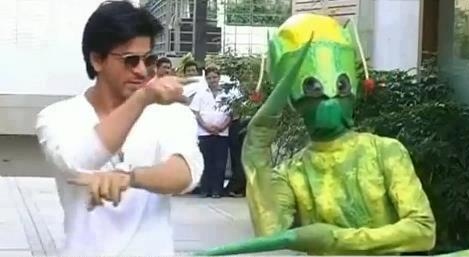In Bollywood, UFO generally refers to the audience's vision of Akshay Kumar before a stage performance. But in the soon-to-be-released Joker, the stunt-prone actor will be the one who spots the Unidentified Flying Object, the "udta firta omelette" as his character calls it.Had it not been for a recent change of plan, this omelette and its extra-terrestrial inhabitants would have come flying at you from the screen. "The initial plan was for Joker to be the first 3D film with a big star," says director Shirish Kunder. "But taking into account the recent responses to 2D versus 3D ventures, we decided to reach out to a wider audience."

Kunder's sense of caution is shared by much of Bollywood. "Big production houses are extremely sceptical about using 3D," says trade analyst Komal Nahta, who does not see a bright future for 3D films in India. And the primary reason, feel insiders, is that 3D is being used more as a "gimmick" than a genuine creative tool.Three years ago, it was James Cameron's Avatar, whose multi-billion-dollar box-office returns started it all. Almost every other Hollywood producer, in a bid
to justify higher ticket prices, started converting 2D films to 3D. Predictably Bollywood, too, jumped on to the conversion bandwagon with Ra.One and Don 2-both, however, did not do as well in the 3D format as they did in 2D. "Releasing a film in 3D is not a sureshot success idea unless it is backed by content that enhances the 3Dexperience," says Shailesh Kapoor, CEO of Ormax Media, a tracking company which found that the word of mouth for Ra.One was better among those who watched it in 2D.
Vikram Bhatt, the only Bollywood director to have shot films (Haunted, Dangerous Ishq and the impending Raaz 3) in 3D, dismisses both Ra.One and Don 2 as "hasty" jobs. "2D is what you see with one eye and 3D is what you see with two. And conversion, unless you are James Cameron who added so many layers of conversion to the film Titanic, is a disservice to 3D," he says.
Not everyone, however, is as mindful of aesthetics-with the result that 3D ends up being used carelessly and for its novelty value without a thought to whether the subject of the film demands it. "You can't expect the audience to lap up a product just because it is in 3D," says Vikram Malhotra, COO of Viacom18 Motion Pictures, which saw success with the 3D releases of Hollywood films such as Transformers, Captain America and Madagascar 3 in India. "The fad of retro-fitting (the addition of new technology or features to older systems), he says, "makes the effects appear a bit unreal and discourages the discerning audience".
Besides, given that only 30% of our theatres are equipped to provide the 3D experience, glasses become just another distraction such as popcorn munchers or mobile ringtones at the cinemas. Pramod Arora, Group President and CEO at PVR Limited, says a film's 3D release ensures at least 1.4 times the income that it garners from 2D but technical loopholes such as flickering glasses, projector not being able to reflect enough light off the screen and 'dark spots' spoils the party.
Thankfully, Hollywood production houses are realizing that audiences are getting smarter and can identify real 3D from pseudo 3D, says Amit Jethani, Director, Multivision Multimedia, which recently released Piranha 3DD. "That is why the number of Hollywood 3D releases has gone down from last year, he says. "Greater care is now being put into the creation."
Not only do they take care to ensure that only certain parts of the film are in 3D so as to avoid audience discomfort, they are also being picky about which genres lend themselves to the format. Closer home, trade analyst Amod Mehra reveals that even director Rakesh Roshan, who abandoned the idea of shooting Krrish 3 in 3D, will decide to give the process of converting the 2D film into 3D a good year or so in order to ensure quality.
But this doesn't mean we should write 3D off, says film reviewer Rajeev Masand. "Outside of America, it's still a big draw," says Masand, who feels Bollywood is tentative since shooting a film in 3D is expensive. "All the industry needs is one successful film that stands out in terms of both content and execution," he says. "That will turn the tide."Bhatt, however, doesn't seem so sure. "The process of learning to shoot in 3D is too laborious for the current star system," he pronounces. "I think 3D in Bollywood lives and dies with me."
